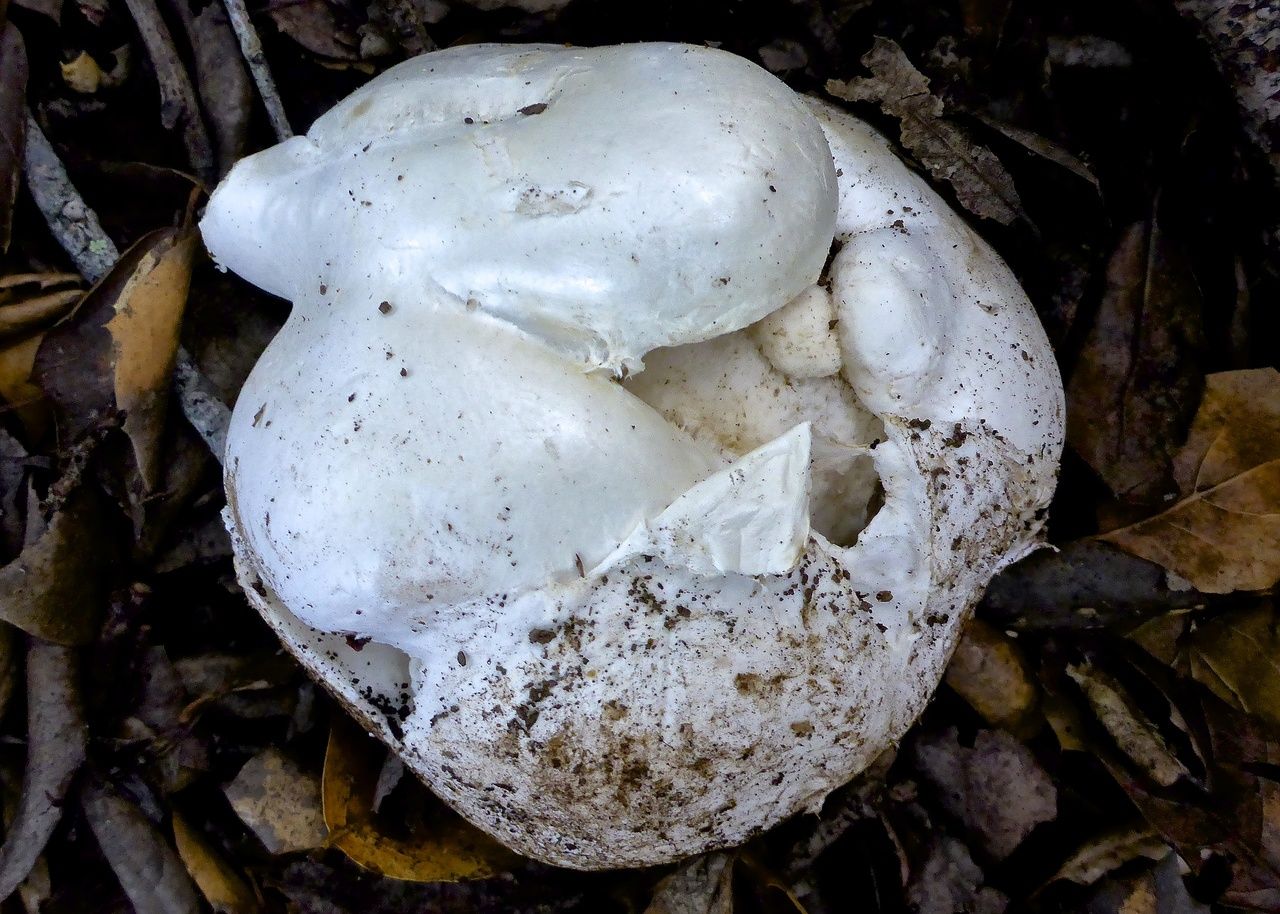Yes, it is an “8-headed Amanita ocreata,” measuring 11 cm across and 9.5 cm tall. I sectioned it to find at least eight caps inside one volva. An Amanita like this has never been reported before. Mycologist Rod Tulloss, who specializes in Amanita, commented, “I can’t remember anything like it.” One suggestion is that at least eight primordia were very crowded together and developed to share a volval sac. Who knows?
Our FunDiS project covers the 46,000 acre Santa Cruz Island Reserve (76% of the island) owned and managed by The Nature Conservancy (TNC). Santa Cruz Island is one of a chain of eight northern channel islands off the southern California coast. Five of the islands are owned in whole or part by the National Park Service (Channel Islands NP). The TNC reserve supports a variety of terrestrial habitats, Including dense oak woodlands (with about 10 species of oak), Bishop Pine (Pinus muricata) forests, grasslands, coastal scrub and others. We have completed three intense, five-day trips, and collected, dried and documented 150 fungal collections.

Our observations are fascinating, in addition to the genetically odd Amanita ocreata (MO 362773). Many represent significant species range extensions; many represent first-time records for these islands; and the DNA barcode sequences for some are not close to anything listed in GenBank. We find a number of mycorrhizal fungi in oak and pine habitats. Some occur in one habitat or the other, while others occur in both. Of course it is exciting each time we find Suillus quiescens (MO 402901) since it was described from collections on this island. When we search for it near where the holotype was collected, we feel like we are walking in the footsteps of mycologists like Tom Bruns, Lisa Grubisha and Jim Trappe who have gone before us. Even rediscovery is exciting! We find lots of the oak-associated Suillellus amygdalinus (MO 403274), often with a surprise hypogeous Rhizopogon occidentalis or possibly a Trappea darkeri (MO 402904) at its base. Sometimes, we find real oddities (at least to us), like a Pleurotus (?) (MO 450397) growing on a 6 foot tall Giant Coreopsis, Coreopsis gigantea, a large flowering shrub. Typically this fungal species grows only on downed Oak and other hardwoods. Of course I’ll get a sequence of each of these and see whether the fungi really are the species they appear to be.

Over the past three years, rainfall on Santa Cruz Is. has ranged from a low of less than 3” to over 31”: normal is 20” each year. So far, 2021 has proven to be a very dry year, with under 3” for the rain year. It will certainly take additional years to document the diversity and role of fungi in each of these habitats. Most of the Bishop Pines have suffered mass mortality from severe drought and accompanying bark beetle infestations, but recruitment seems high in some stands, with many new trees rising. Are different fungi growing with the new trees than with the mature trees? Are different species associated with the 100-300 year old Oaks than with the 50 year old trees and with the youngest trees? And do different species associate with various species of Oak? So much left to learn!

As a FunDiS project, this one is more complicated than most. Permission to collect is required for the Reserve. Accessing the Island always requires lots of logistics and coordination, especially during this past Covid year. Getting to the Island requires a 2.5 hour drive from our home to Ventura Harbor, where a commercial boat takes us almost 20 miles to the island. Once on the Island, we drive 4 miles on a dirt track to our research housing and lab. Over the course of a five day field trip, we will drive almost 100 miles over rough dirt roads. Hiking along the roads and trails in the canyon bottoms is easy, but moving through the Bishop Pine forests, around -- over and under -- extraordinary amounts of dead and downed wood, can be extremely strenuous. And tip-toeing through the Oak woodlands requires a keen eye for barely emergent poison oak. Doing field work here is not quite like heading off to our nearby wilderness areas to collect mushrooms. Despite the challenges, the rewards of working on the Island are certainly worth the effort.

Requirements for a FunDiS project are also challenging and time consuming. Collecting the fungi is the easy part. On the island we take copious photographs and notes on advanced field slips, then clean, dry and freeze each collection. At home I log them into an expansive spreadsheet, prepare and upload images and data to Mushroom Observer. Eventually I sort through the data and collections and select some for DNA study, snipping bits appropriate for each group of fungi, putting them in tiny tubes and sending them off to be barcoded. Then I try to understand the molecular data, but at this point it is beyond my skill level and I won’t have solid ID’s until all of our sequence data is analyzed. So some very helpful mycologists, like Jean Lodge of Georgia and Bitty Roy of Oregon, jump in to do sequence editing and blasting to come up with possible IDs, as well as lists of those which do not match well any sequences currently logged in GenBank, the big fungal database in the sky. Dried specimens will be vouchered permanently at the Santa Barbara Botanic Garden and eventually some of our data will be worked up to describe new species. Although not required by FunDiS, I submit periodic research updates to TNC and others to encourage ongoing dialogue.
Why do we do this? My photographer husband, Doug (who expertly carries the mushroom basket), and I love to study fungi and we have learned a great deal during the almost three years of this project. We crave exploring this spectacular island. It is not unusual for our mushroom activities to be interrupted by sightings of tiny endemic Santa Cruz Island Foxes, giant SCI Scrub Jays, endemic Rufous-crowned Sparrows, native Bald Eagles, island Spotted Skunks and more. As we walk, we’ve examined a number of Channel Island endemic plants on Santa Cruz, like endemic Dudleya, Silver Lotus and Ironwood. It is also fun to think about the Island’s rich archeological and cultural histories, from the early human inhabitants some 13,000 years ago through the ranching days of the 19th and 20th centuries.
My husband and I each have a personal history with this land (actually all eight northern channel islands). When eight years old I lived on a mainland coastal cliff and received a WWII Navy spyglass as a birthday present. I scanned the islands for many hours, always dreaming about what it would feel like to walk and live there. Over the years, Doug and I have kayaked extensively throughout the northern Channel Islands, circumnavigating Santa Cruz and three other Islands, and paddling from the mainland to and from the Islands. We have also hiked, camped, and done studies or restoration projects on each of the eight islands. This Island archipelago is deeply embedded in our hearts so our mycology work is a joy.

A little advice to FunDiS projects
- Pick a location you love.
- Pick a range of fungal species which really interest you.
- Learn about the species you find - their habitats, associations, ecological functions.
- Do a deep dive into the collecting and documenting protocols: take better images.
- Write more complete notes.
- Keep track of your discoveries in a spreadsheet or database.
- Dry, sequence and voucher your most interesting finds.
- Share your experiences and learning with others.
- Consider long term collecting and documenting - perhaps five years, instead of a season or two.
Our hope for the future is to continue this project and to expand it to nearby Santa Rosa Island. Longitudinal data is especially valuable in understanding the roles fungi play in these landscapes. Given the critical importance of fungi to plants and trees, more documentation of fungi will be important to preserving this Island’s unique biodiversity. As we learn identifications of more of our findings through genetic barcoding, and determine which of our collections represent range extensions, which are new species for Santa Cruz Island, and which might even be new mushroom species, we will be able to better target our ongoing work.
We hope that our Fungal Diversity Survey data will increase understanding the ecology of the Santa Cruz Island Reserve as well as that of other nearby islands. We are proud to contribute to long term conservation efforts of TNC and the National Park Service on these spectacular islands.
Resources
Fungal Diversity Survey FunDiS.org
Macrofungi of the Channel Islands (CA) FunDiS project observations Mushroom Observer (always in progress)
Santa Cruz Island NPS overview
Santa Cruz Island in Natural Reserve System
Santa Cruz Island TNC Reserve





